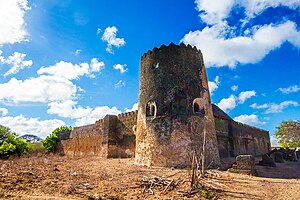Godfather (island)
| Godfather | ||
|---|---|---|
| Siyu Fort on Pate Island | ||
| Waters | Indian Ocean | |
| Archipelago | Lamu Archipelago | |
| Geographical location | 2 ° 6 ′ S , 41 ° 3 ′ E | |
|
|
||
| length | 24 km | |
| width | 11.6 km | |
| Highest elevation | 46 m | |
| main place | Siyu | |
| Map of the island of Godfather | ||
Pate is an island in the Lamu Archipelago on the north coast of Kenya . It is the closest island to the mainland. At high tide godfather is near the village of Siyu by a tidal creek divided into two halves, which falls dry at low tide. The island has a length of 24 kilometers and is almost 12 kilometers wide. In the north it reaches a height of 46 meters.
Pate is one of the first places visited by Arab traders and seafarers since the 7th or 8th century AD. There is no reliable evidence that one of the coastal towns of Azanias named in the Periplus of the Erythrean Sea was here.
Important cities of the Swahili culture developed on the island . The earliest settlement of Arab Muslims on the island and the entire East African coast is the ruined city of Shanga in the southeast of the island. A little later, the village of Pate was settled for the first time, but was not expanded into a town until the 13th century, as was Faza , 20 kilometers to the east , where the ruins of a mosque from the 18th century are. The first stone buildings in Siyu in the center of the island were built in the 15th century. From the 17th to 19th centuries, Siyu was the largest place on the island. The island towns sometimes fought with Lamu for supremacy in the archipelago until the Sultan of Oman ended the dispute in 1847 in favor of Lamu.
After the victory of the Ethiopian emperor over the jihad of Ahmad Gran in 1542 and in the following century, many Muslims moved from the Horn of Africa to Pate. They were devout followers of a Sufi order that arose in the Hadramaut . In contrast, the missionary attempts by Portuguese seafarers from 1598 onwards were unsuccessful, and the Augustinian brothers in their entourage were not welcome here as elsewhere on the coast. The island remained under Portuguese rule until it was conquered by the Sultan of Oman in 1698. In 1727, however, the Sultan of Pate asked the Portuguese viceroy of Goa for protection and the latter dispatched a fleet of six ships under the command of Luis de Melo de Sampaio . Also Mombassa surrendered on March 15, 1728. On August 24, a peace agreement was signed and Portugal built a fortress on Pate with 150 crew. City commander and governor was António de Albuquerque Coelho , who withdrew at the end of 1729 because the Portuguese commander of Mombassa withheld supplies from him. Pate and Lamu became centers of expansion for Islam in the 19th century. The island had been under the sovereignty of the sultans of Oman since the displacement of the Portuguese from Mombasa .
In the 17th century, after the decline of Kilwa Kisiwani , Pate took over its role as an economic and religious center. Ships landed here on their way from Mecca to Madagascar . Trade relations existed as far as Java . The island's population was on friendly terms with the mainland, and the residents of Pate were also farmers there. Rice and millet were produced in exportable quantities. The island was a major trading place for ivory and other animal products from the interior, slaves were exported and at the same time obliged to work in their own fields. In the 19th century, the affiliation of the godfather passed to the Sultan of Zanzibar , who only had to enforce it in several campaigns, especially against Siyu. The importance of the island to Lamu decreased.
Faza is the largest place on the island of Godfather. The police station, shops, schools, a small hospital and an inn are located here. The only vehicle in 2004 was an ambulance.
Individual evidence
Web links
literature
- Randall L. Pouwels: The East African Coast, C. 780 to 1900 CE In: Nehemia Levtzion and Randall L. Pouwels: The History of Islam in Africa. Ohio University Press, Athens (Ohio) 2000, pp. 259-261


